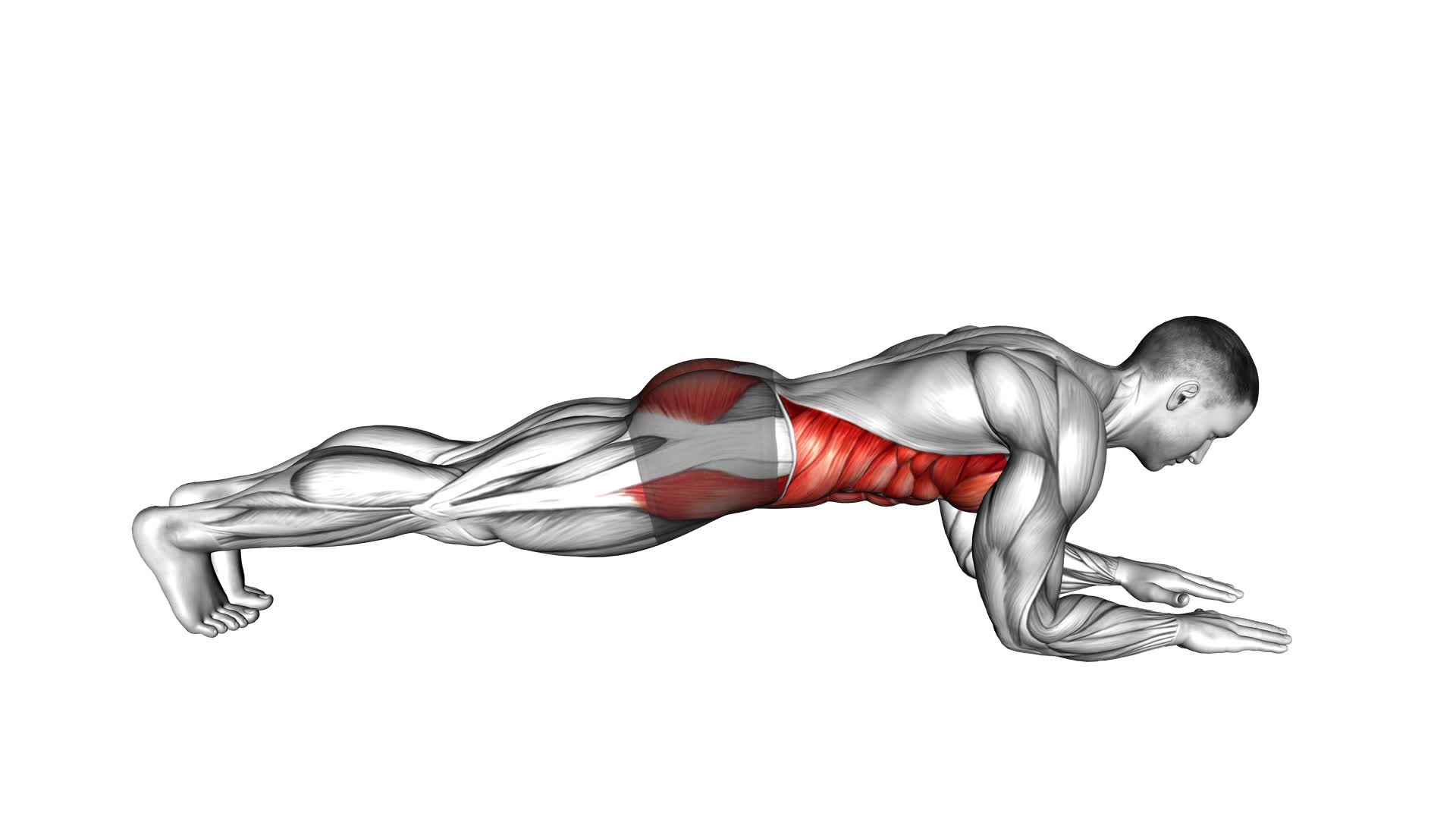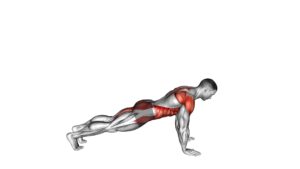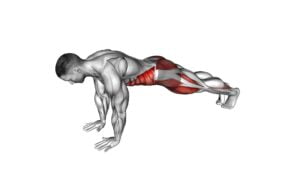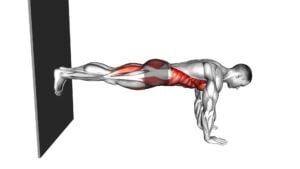Front Plank (male) – Video Exercise Guide & Tips

Looking to strengthen your core? Check out our video exercise guide for the front plank (male). This article will provide you with tips and proper form to maximize your workout.
Watch This Exercise Video
Learn how to avoid common mistakes and progress your routine to increase difficulty. We'll also give you tips on engaging your abdominal muscles effectively.
Get ready to plank like a pro with our sample front plank workout routine. Let's get started!
Key Takeaways
- Front plank targets core muscles and improves overall strength and stability.
- Maintaining proper form and technique is crucial for maximum benefits and to prevent injuries.
- Avoid common mistakes such as sagging hips, hunching shoulders, and failing to activate the correct muscles.
- Progress and increase difficulty by increasing plank duration, incorporating variations, adding resistance, and challenging yourself while maintaining proper alignment.
Benefits of Front Plank for Males
You should regularly incorporate the front plank into your workout routine as it offers numerous benefits for males. Not only does it target your core muscles, but it also helps improve your overall strength and stability. The front plank can be modified to suit your specific needs as a male, allowing you to challenge yourself and progress at your own pace.
When it comes to male plank modifications, you can try adding variations such as lifting one leg or arm off the ground, or even incorporating a stability ball. These modifications engage additional muscles and increase the intensity of the exercise, helping you achieve greater results.
While both the front plank and side plank are effective exercises, the front plank specifically targets your abdominal muscles, including your rectus abdominis and obliques. This makes it a great choice for strengthening your core and improving your posture.
In the subsequent section about proper form and technique for the front plank (male), we'll discuss how to perform the exercise correctly to maximize its benefits and minimize the risk of injury. It's important to maintain proper form and technique to ensure that you're getting the most out of your workout.
Proper Form and Technique for Front Plank (Male)
To perform the front plank (male) exercise correctly and effectively, focus on maintaining a straight line from your head to your heels throughout the entire duration of the exercise. This proper form and technique are crucial for maximizing the benefits of planking for overall strength and stability.
Firstly, start by positioning yourself face down on the ground, resting on your forearms and toes. Your elbows should be directly under your shoulders, and your body should form a straight line from your head to your heels. Engage your core muscles to keep your body stable and prevent your hips from sagging or lifting too high.
Remember to breathe steadily and avoid holding your breath during the exercise. Aim to hold the plank position for at least 30 seconds, gradually increasing the duration as you become stronger.
If you find the front plank too challenging, there are modifications you can try. One option is to perform the exercise with your knees bent and resting on the ground, still maintaining a straight line from your head to your knees. This modification reduces the load on your core muscles, making it easier to maintain proper form.
Common Mistakes to Avoid During Front Plank (Male)
Maintain a straight line from your head to your heels to avoid common mistakes during the front plank (male) exercise. Proper alignment is crucial for maximizing the benefits of this exercise and preventing injuries.
One common mistake to avoid is letting your hips sag towards the floor. This not only reduces the effectiveness of the exercise but also puts unnecessary strain on your lower back. To fix this, engage your core muscles and squeeze your glutes to keep your hips lifted and in line with the rest of your body.
Another mistake is allowing your shoulders to hunch or your head to drop. This can lead to neck and shoulder discomfort. Instead, keep your shoulders directly above your elbows and your head in line with your spine.
Lastly, some people fail to activate the correct muscles during the front plank. To ensure proper muscle activation, focus on engaging your core, squeezing your glutes, and keeping your shoulder blades pulled down and back.
How to Progress and Increase Difficulty in Front Plank (Male)
To enhance the challenge of the front plank exercise for males, there are several ways to progress and increase difficulty while maintaining proper alignment and muscle activation.
One way to increase difficulty is by increasing the duration of the plank. Start by holding the plank for 30 seconds, and gradually work your way up to one minute or longer.
Another way to progress is by incorporating variations of the front plank. For example, you can try side planks or elevated planks, which engage different muscle groups and add more intensity to the exercise.
Additionally, you can add resistance by placing a weight plate on your back or wearing a weighted vest. This will further challenge your core muscles and increase the difficulty of the exercise.
Lastly, you can try performing the plank on an unstable surface, such as a stability ball or a BOSU ball, to engage more stabilizer muscles.
By implementing these progression tips and increasing the difficulty of the front plank, you can continue to challenge yourself and see greater improvements in your core strength and stability.
To engage your abdominal muscles effectively during the front plank exercise, there are some important tips to keep in mind.
Tips for Engaging Abdominal Muscles During Front Plank (Male)
To effectively engage your abdominal muscles during a front plank, focus on your breathing techniques. Take deep breaths in and exhale fully, using your diaphragm to activate your core.
Additionally, use cues such as pulling your belly button towards your spine and squeezing your glutes to ensure proper core activation.
Breathing Techniques for Planks
Engage your abdominal muscles effectively during the front plank (male) by implementing proper breathing techniques. Breathing plays a crucial role in activating your core muscles during the plank exercise.
To engage your abdominal muscles, focus on taking deep breaths in through your nose and exhaling fully through your mouth. As you inhale, imagine expanding your belly, allowing the air to fill your diaphragm. This helps create stability and engagement in your core.
As you exhale, imagine pulling your belly button towards your spine, contracting your abdominal muscles. This breathing technique not only helps you maintain a stable plank position but also increases the activation of your abdominal muscles, making your plank more effective.
Remember to maintain a steady breathing rhythm throughout the exercise for optimal core activation.
Core Activation Cues
To effectively engage your abdominal muscles during the front plank (male), focus on activating your core using these helpful cues.
Core engagement is crucial for maintaining proper form and maximizing the benefits of the exercise.
Firstly, make sure to tighten your abdominal muscles by imagining that you're pulling your belly button towards your spine. This will help to stabilize your spine and maintain a strong, neutral position.
Secondly, engage your glutes by squeezing your buttocks together. This won't only activate the muscles in your posterior chain but also provide additional stability and support.
Lastly, ensure proper plank variations by maintaining a straight line from your head to your heels, avoiding sagging or arching of the lower back.
Common Mistakes to Avoid
To prevent mistakes and effectively engage your abdominal muscles during the front plank (male), focus on the following tips:
- Maintain proper form: Keep your body in a straight line from head to toe, ensuring that your hips aren't sagging or raised too high.
- Engage your core: Squeeze your abdominal muscles and imagine pulling your belly button towards your spine to activate your core.
- *Preventing injuries*: Engaging your core will help stabilize your spine and reduce the risk of strain or injury.
- *Modifications for different fitness levels*: If you're a beginner, start with modified planks on your knees or forearms. As you progress, challenge yourself by extending your legs or adding variations like side planks or plank jacks.
By following these tips, you can maximize the benefits of the front plank while minimizing the risk of injuries.
Remember to listen to your body and make modifications as needed to suit your fitness level.
Sample Front Plank (Male) Workout Routine
Now let's talk about some important points to consider when incorporating the front plank into your workout routine.
As a beginner, you can start with variations that suit your fitness level and gradually increase the intensity.
Additionally, practicing the front plank daily can provide numerous benefits, including improved core strength, stability, and posture.
Variations for Beginners
Start with the basic front plank exercise and progress to more challenging variations for a complete workout routine. As a beginner, it's important to focus on proper alignment and modifications to ensure you're performing the exercise correctly. Here are some variations to consider:
- Knee Plank: Start by performing the front plank on your knees instead of your toes. This modification reduces the intensity and allows you to work on building core strength.
- Forearm Plank: Instead of being on your hands, lower down to your forearms. This variation engages the muscles in your core and shoulders in a slightly different way.
Benefits of Daily Practice
As you continue to incorporate variations into your routine, daily practice of the front plank exercise can provide numerous benefits for your overall fitness and strength.
Making the front plank a part of your daily routine helps to strengthen your core muscles, including the abdominals, obliques, and lower back. By engaging these muscles consistently, you can improve your stability and balance, which can have a positive impact on your performance in other exercises and physical activities.
Additionally, daily practice of the front plank can help to improve your posture and reduce the risk of back pain. It also promotes better spinal alignment and can enhance your body's ability to withstand daily activities and movements.
Incorporating this exercise into your daily routine is a great way to develop core strength and improve your overall fitness level.
Frequently Asked Questions
How Long Should I Hold the Front Plank Exercise for Optimal Results?
To get the most out of the front plank exercise, it's important to hold it for the right amount of time.
The optimal duration for a front plank is typically around 30-60 seconds. Holding the position for this length of time allows your muscles to engage and strengthen, leading to various benefits such as improved core stability, posture, and overall strength.
As you progress, you can increase the duration or try more challenging variations to continue seeing results.
Can Front Plank Exercises Help to Improve Posture?
Front plank exercises can indeed help improve your posture. By engaging your core muscles, these exercises promote proper alignment and stability in your spine and shoulders. This can lead to better posture over time.
Additionally, front plank exercises are great for athletes looking to improve their core strength, as they challenge your abdominal muscles and enhance overall stability.
Pregnant women can also benefit from front plank exercises, as they can be modified to suit their changing bodies and help maintain core strength throughout pregnancy.
Is It Necessary to Warm up Before Performing Front Plank Exercises?
Before performing front plank exercises, it's necessary to warm up. Warming up helps prepare your muscles and joints for the intensity of the exercise, reducing the risk of injury. It increases blood flow, loosens up tight muscles, and improves overall performance.
If you don't want to warm up, there are alternative exercises you can do to activate your core muscles, such as plank variations or dynamic stretches. However, warming up is highly recommended for optimal results.
Are There Any Modifications or Variations of the Front Plank for Beginners?
There are several modifications and variations of the front plank that are suitable for beginners. These modifications can help you build strength and stability gradually.
For example, you can start by performing a modified plank on your knees instead of your toes.
Another variation is the forearm plank, where you rest on your forearms instead of your hands.
These beginner variations allow you to gradually progress and work towards the full front plank exercise.
Can the Front Plank Exercise Help to Reduce Lower Back Pain?
The front plank exercise is known for its many benefits, including its potential to reduce lower back pain. By engaging your core muscles, the front plank helps to stabilize your spine and improve your posture, which can alleviate pressure on your lower back.
To perform this exercise correctly, start by lying face down on the floor and then lift your body up onto your forearms and toes, keeping your body in a straight line.
Conclusion
In conclusion, the front plank exercise is a highly effective way for males to strengthen their core muscles. By maintaining proper form and avoiding common mistakes, individuals can maximize the benefits of this exercise.
Gradually increasing difficulty and engaging abdominal muscles can further enhance the effectiveness of the front plank. Incorporating this exercise into a regular workout routine can lead to improved core strength and overall fitness for males.

Author
Years ago, the spark of my life’s passion ignited in my mind the moment I stepped into the local gym for the first time. The inaugural bead of perspiration, the initial endeavor, the very first surge of endorphins, and a sense of pride that washed over me post-workout marked the beginning of my deep-seated interest in strength sports, fitness, and sports nutrition. This very curiosity blossomed rapidly into a profound fascination, propelling me to earn a Master’s degree in Physical Education from the Academy of Physical Education in Krakow, followed by a Sports Manager diploma from the Jagiellonian University. My journey of growth led me to gain more specialized qualifications, such as being a certified personal trainer with a focus on sports dietetics, a lifeguard, and an instructor for wellness and corrective gymnastics. Theoretical knowledge paired seamlessly with practical experience, reinforcing my belief that the transformation of individuals under my guidance was also a reflection of my personal growth. This belief holds true even today. Each day, I strive to push the boundaries and explore new realms. These realms gently elevate me to greater heights. The unique combination of passion for my field and the continuous quest for growth fuels my drive to break new ground.







